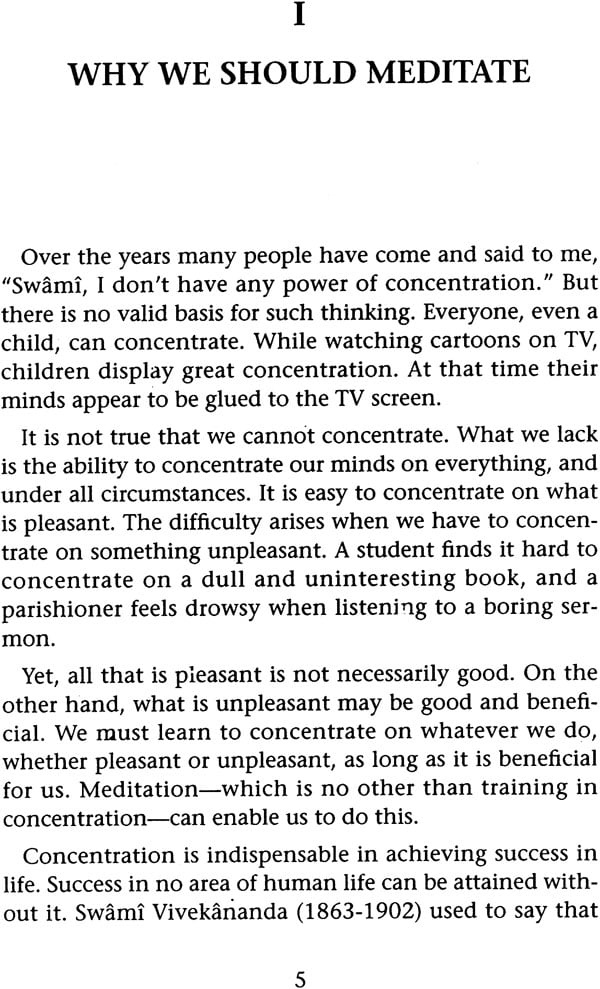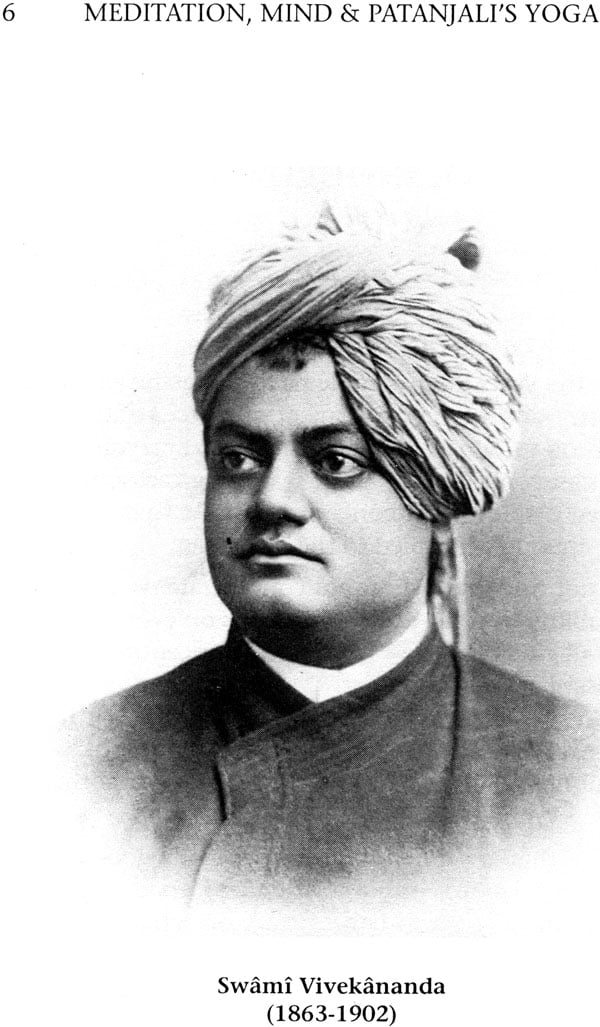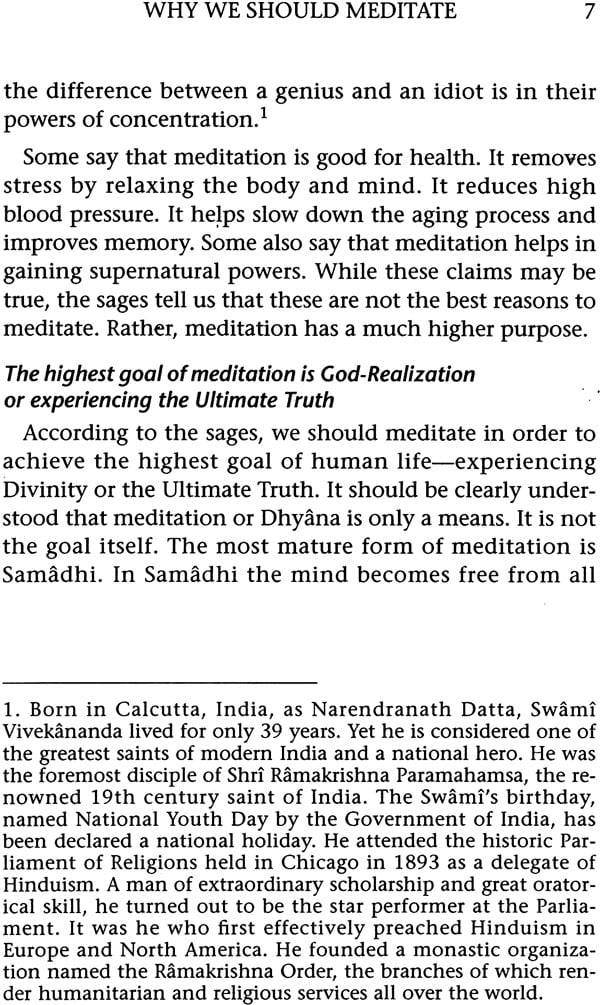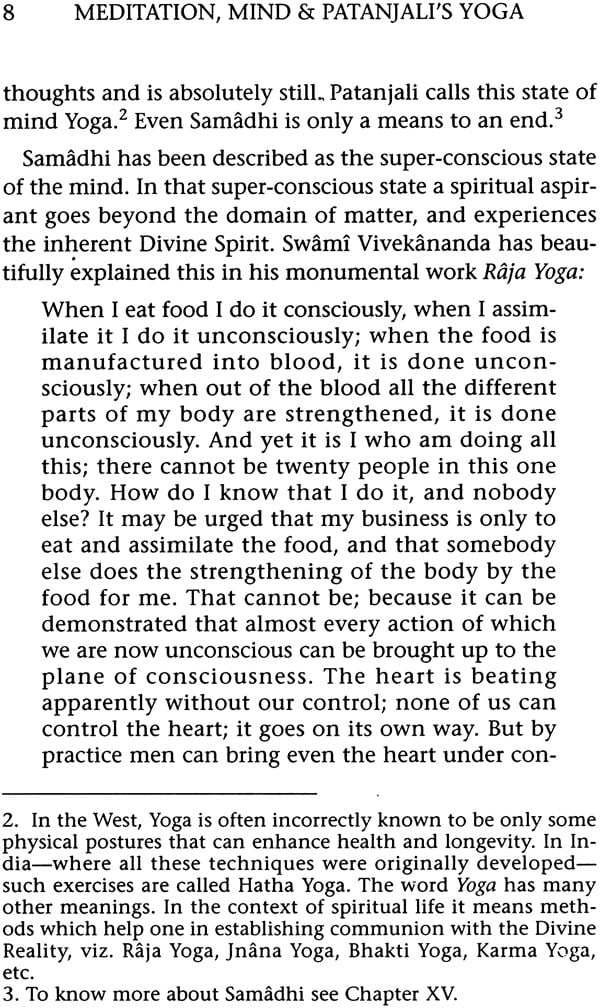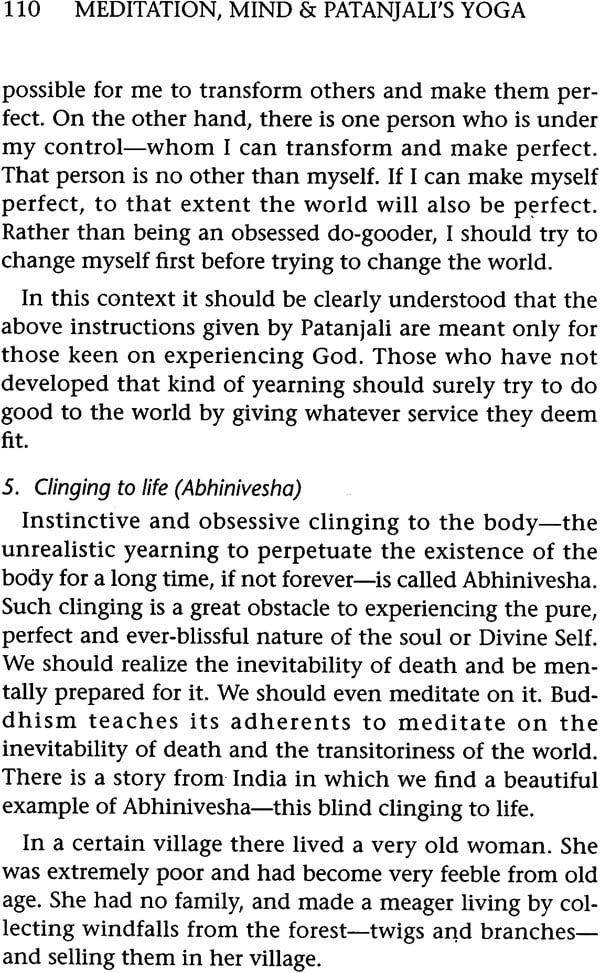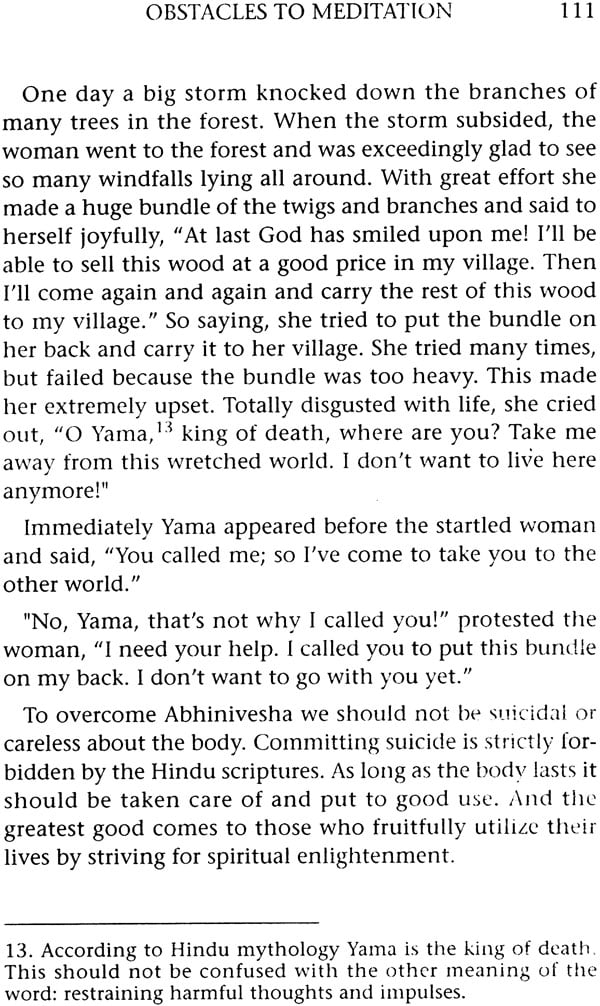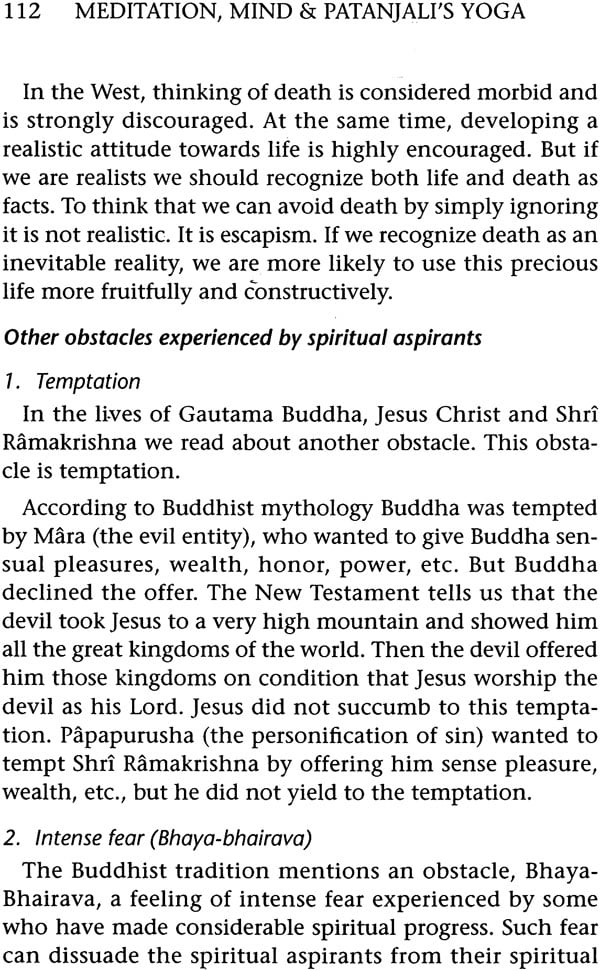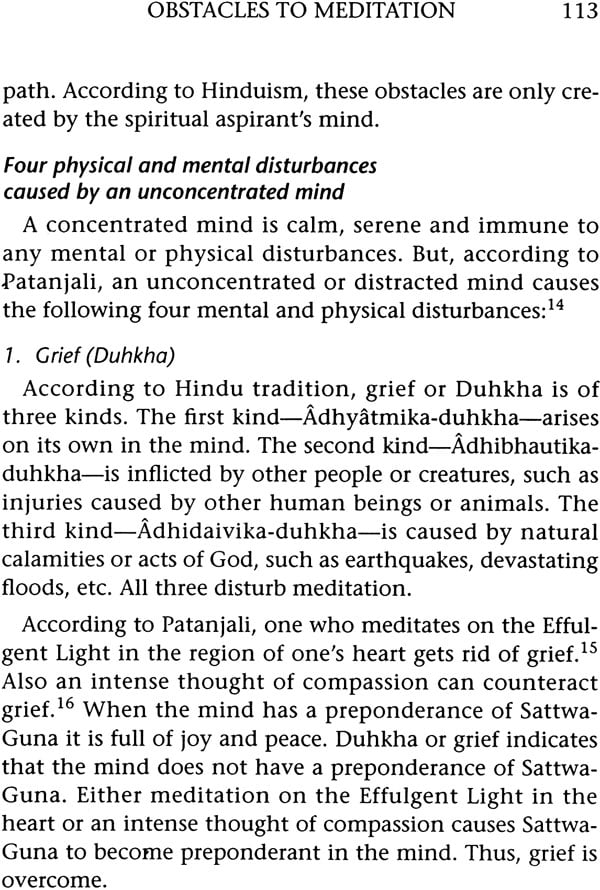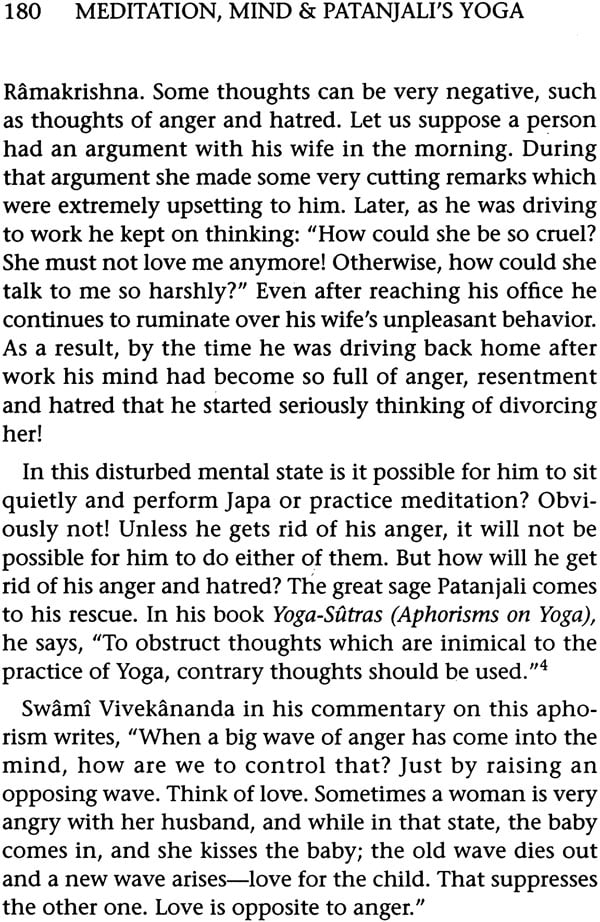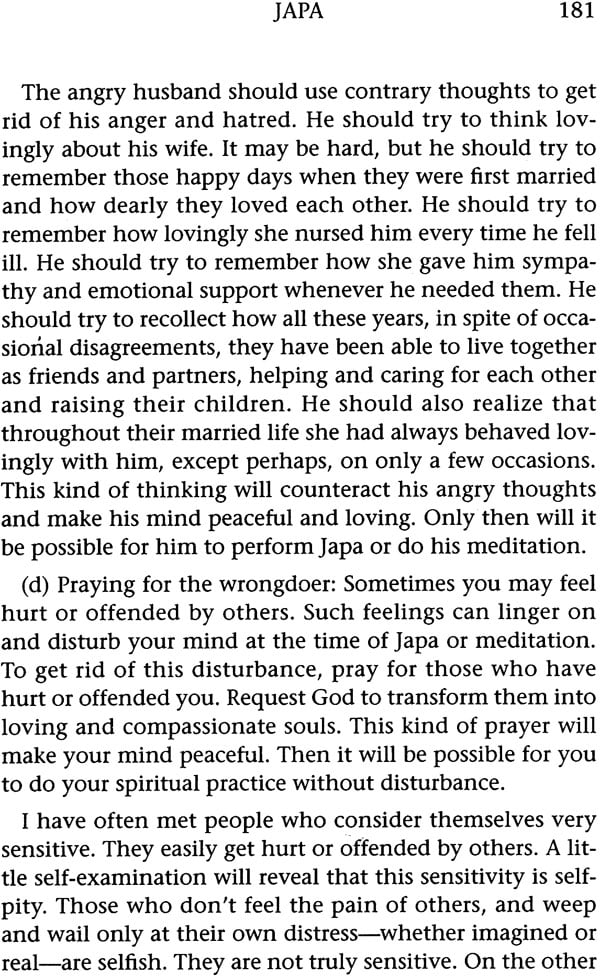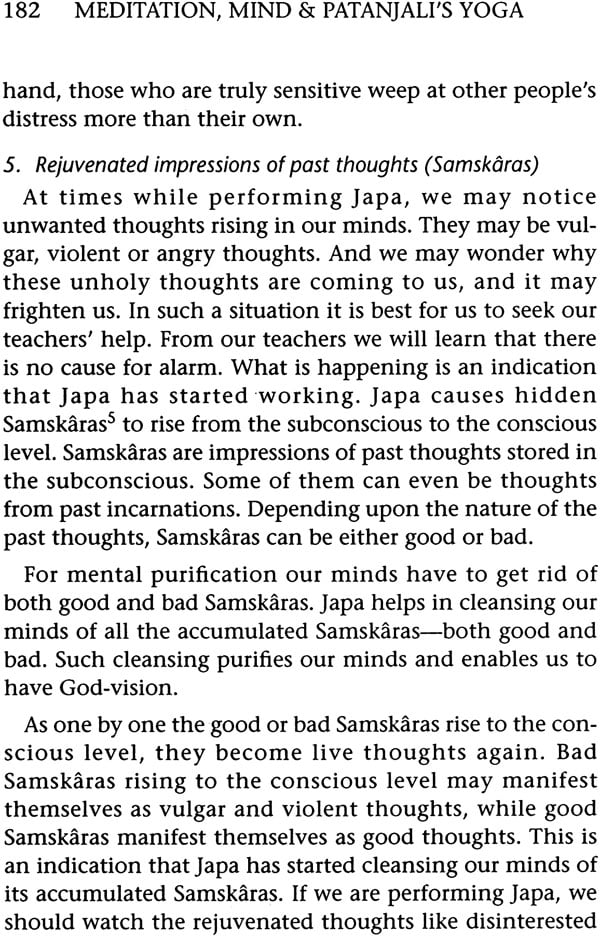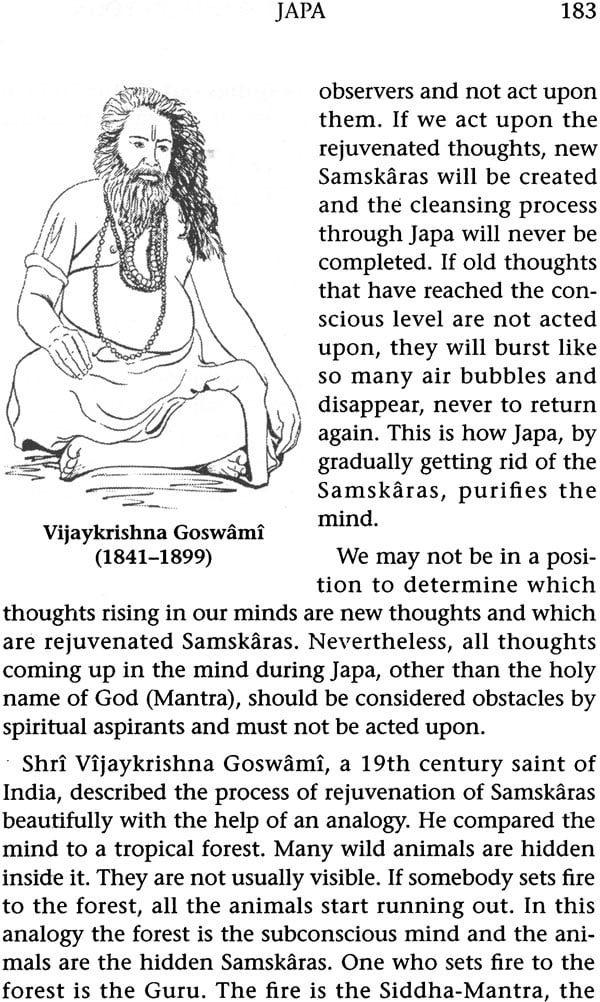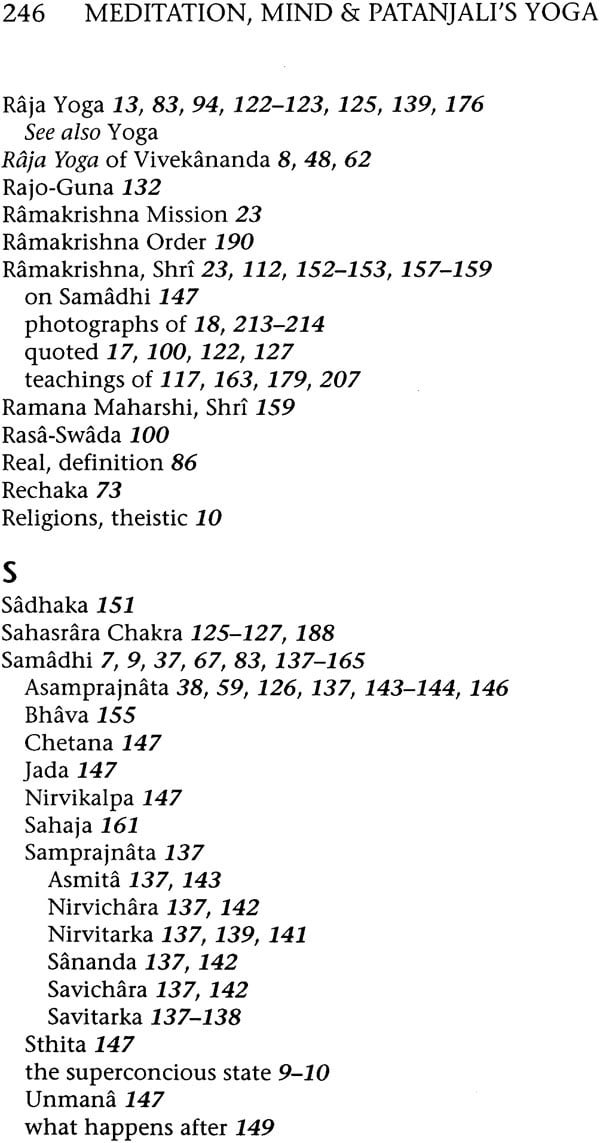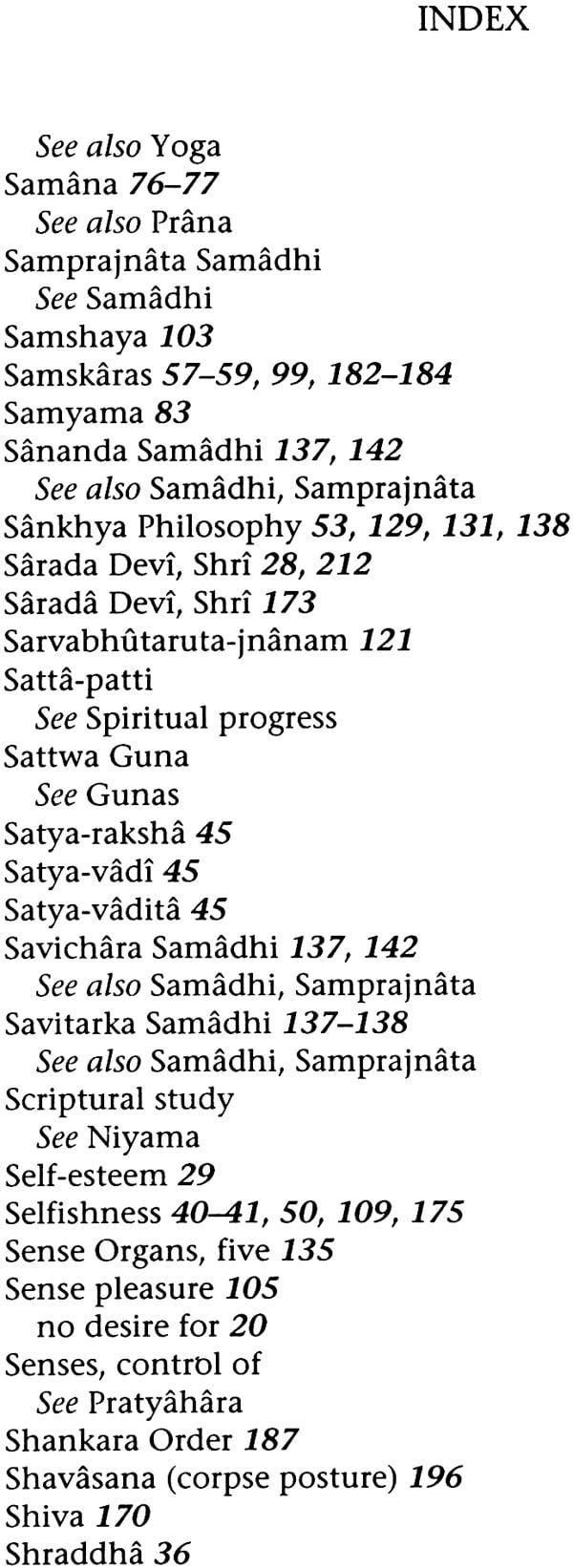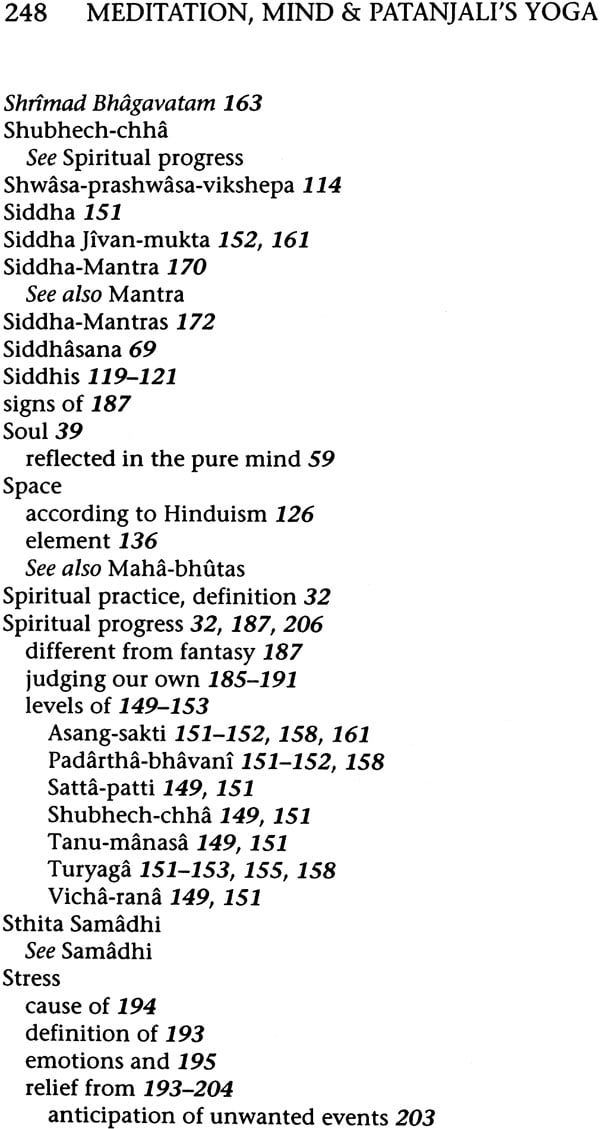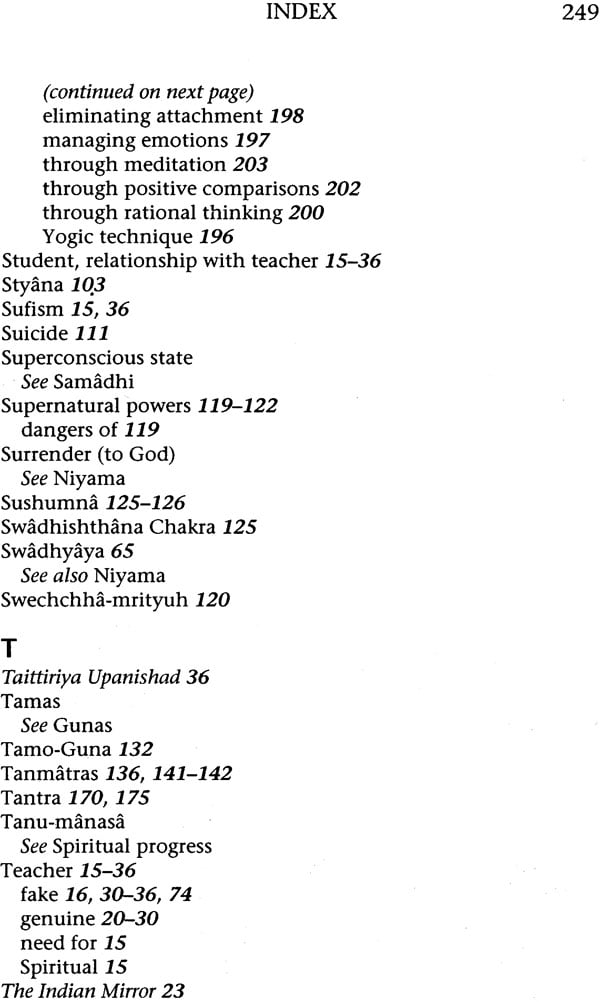
Meditation: Mind and Patanjali's Yoga
Book Specification
| Item Code: | IDG623 |
| Author: | Swami Bhaskarananda |
| Publisher: | Sri Ramkrishna Math |
| Language: | English |
| Edition: | 2019 |
| ISBN: | 8171209912 |
| Pages: | 270 |
| Cover: | Paperback |
| Other Details | 7.9 |
| Weight | 330 gm |
Book Description
brief_comments
Reviews:
An Important characteristic of the author is his ability to analyze a subject from all points of view, all possibilities, never having a partial unilateral vision. He always searches for the deepest and the most correct meaning. To have this broader enlightened view from one of the most important ancient subjects of Indian Philosophy is a reward to everyone who will have the opportunity to read this book.
- Suzana de Albuquerque Paiva, Jungian Psychologist chief of the Department of Psychology at the Hospital Prontocor Professor in Faculty of Human Sciences Fundacao Mineira de Educacao e Cultura Belo Horizonte, Barasil
Swami Bhaskarnanda has developed a good rapport with Western ideation; he has explained Patanjali in terms which can be easily understood and has done it well.
By helping to bring the wisdom of the East to the West the Swami provides a fertile basis for the genesis of ideas. This book should be of great interest to a very wide readership.
-Dr. David Longaden, Ma, MB, B. Chir, (cantab.), DPM, FLCOM, Dorset, England.
I have gone through Swami Bhaskarananda's book, Meditation, mind and Patanjali's Yoga. The manuscript is wonderful. Very clear and very very well presented. I thoroughly enjoyed it. I myself would buy it and would recommend it to my students too.
Prof. John Grimes Dept of Religious Studies Michigan State University
The Book provides a clear, interesting, and comprehensive survey of the Yoga system, from ethics to meditation. Not only does it competently summarize Patanjali's Yoga Sutras, it explains in detail the basic concepts of Sumkhya philosophy, particularly the three gunas, and the fundamentals of Kundalini yoga, most notably the seven Chakras. Examples of Yogic practice are given from the experiences of Swami Bhaskarananda, supplemented with stories from the lives of Sri Ramakrishna and other Hindu saints. This book provides a gentle introduction to the spirituality of India in a Manner accessible to everyone, regardless of ethnicity or religious background. It has been a pleasure and inspiration to read this book!
Christopher Key Chapple Professor of Theological Studies Director, Asian and Pacific Studies Loyola Marymount University
It is a wonderfully rich and mature treatise on meditation and growth in the spiritual life, with many fine observations which should help beginners-and more advanced practitioners as well-to advance along the spiritual path. It is not only a clear exposition of yoga, but it is also a book about integral spiritual development which is reasonably will attuned to life in America today. It deserves serious notice and wide reading.
He speaks from a tradition with good common sense and a sense of rooted-ness. It is a strength of the book that it is focused concisely on Yoga and Yoga works.
Francis X. Clooney, S.j. Professor of Theology Boston College.
| List of Illustrations and diagrams | xiii | |
| Preface | xv | |
| Pronunciation Guide | xvii | |
| INTRODUCTION
| 1 | |
| I | WHY WE SHOULD MEDITATE | 5 |
| The highest goal of meditation is God-Realization or experiencing the Ultimate Truth | 7 | |
| Methods of God-realization-the four Yogas | 12 | |
| II | TEACHER AND STUDENT RELATIONSHIP | 15 |
| Why we need a teacher | 15 | |
| The difficulty of finding a competent teacher and avoiding spurious ones | 16 | |
| Characteristics of genuine spiritual teachers | 20 | |
| Some tactics of fake spiritual teachers | 30 | |
| What happens when a sincere spiritual seeker becomes a victim of a false teacher? | 35 | |
| Sharaddha-a necessary ingredient of student life | 36 | |
| III | STEPS TO YOGA | 37 |
| Patanjali's eight-step discipline to Yoga | 37 | |
| IV | YAMA | 39 |
| 1. Non-Killing | 39 | |
| 2. Truthfulness | 41 | |
| 3. Non-Stealing | 45 | |
| 4. Celibacy | 46 | |
| Celibacy for monastics | 46 | |
| Celibacy for married people | 47 | |
| Other benefits of celibacy | 47 | |
| Society and the practice of celibacy | 49 | |
| Lustfulness and its varieties | 49 | |
| Why lustfulness is harmful for spiritual life | 50 | |
| 5. Nonacceptance of unnecessary gifts | 52 | |
| V | NIYAMA | 53 |
| 1. Keeping the body and mind clean | 53 | |
| Pure mind-and how to acquire it | 53 | |
| The three Gunas | 54 | |
| The Gunas can only be known indirectly | 54 | |
| Characteristics of the Gunas | 54 | |
| The Gunas constitute the entire cosmos | 56 | |
| Sattwa Guna is essential for purity of mind | 56 | |
| Smskaras or impressions of past thoughts | 57 | |
| How to eliminate Samskaras | 57 | |
| A pure mind enables us to experience God | 60 | |
| Maintaining physical cleanliness | 61 | |
| 2. Being content with the bare necessities of life | 63 | |
| 3. Getting used to physical and mental austerities | 64 | |
| 4. Regular study of the scriptures and chanting the holy name of God (Swadhyaya) | 65 | |
| 5. The practice of surrendering to God (Ishwara-pranidhana) | 65 | |
| VI | ASANA | 69 |
| VII | PRANAYAMA | 73 |
| What is Pranayama? | 73 | |
| Dangers associated with the practice of Pranayama | 73 | |
| Necessary qualifications for a student of Pranayama | 75 | |
| True meaning of the word Pranayama | 76 | |
| A safer alternative to the practice of Pranayama | 78 | |
| VIII | PRATYAHARA | 79 |
| IX | DHARANA | 81 |
| Dharana matures into Dhyana, and Dhyana into Samadhi | 83 | |
| X | DHYANA | 85 |
| Meditation is guided imagination of the real | 86 | |
| What we meditate on, we become | 88 | |
| Some lessons on meditation (Dhyana) | 89 | |
| Where to meditate | 90 | |
| What is the best time for meditation? | 91 | |
| Words of caution | 92 | |
| Preparation for meditation | 93 | |
| How to start your meditation | 94 | |
| Meditations according to Raja Yoga | 94 | |
| First meditation | 94 | |
| Second meditation | 94 | |
| Third meditation | 94 | |
| Forth meditation | 95 | |
| Meditation according to Bhakti Yoga | 95 | |
| Meditation according to Jnana Yoga | 96 | |
| General points about all meditation techniques | 96 | |
| XI | OBSTACLES TO MEDITATION | 97 |
| Obstacles mentioned in Vedantasara | 97 | |
| 1. Sleep (Laya) | 97 | |
| 2. Wandering of the mind (Vikshepa) | 98 | |
| 3. Reluctance to practice meditation (Kashaya) | 99 | |
| 4. Getting stuck in an intermediate joyful spiritual experience (Rasa-Swada) | 100 | |
| Nine obstacles mentioned by Patanjali | 102 | |
| 1. Disease (Vyadhi) | 103 | |
| 2. Lack of interest (Stayana) | 103 | |
| 3. Doubt (Samshaya) | 103 | |
| 4. Delusion (Pramada) | 104 | |
| 5. Lethargy (Alasya) | 105 | |
| 6. Reluctance to give up sense pleasures (Avirati) | 105 | |
| 7. Erroneous conception (Bhranti-darshana) | 105 | |
| 8. Non-attainment of any level of concentration (Alabdha-bhumikatwau) | 106 | |
| 9. Inability to retain a level of concentration once attained (Anavasthitatwa) | 106 | |
| Five more subtle obstacles recognized by Patanjali | 106 | |
| 1. Ignorance of one's inherent divine nature (Avidya) | 106 | |
| 2. Egoism (Asmita) | 107 | |
| 3. Attachment (Raga) | 108 | |
| 4. Aversion (Dwesha) | 108 | |
| 5. Clinging to life (Abhinivesha) | 110 | |
| Other obstacles experienced by spiritual aspirants | 112 | |
| 1. Temptation | 112 | |
| 2. Intense fear (Bhaya-bhairava) | 112 | |
| Four physical and mental disturbances caused by an unconcentrated mind | 113 | |
| 1. Grief (Duhkha) | 113 | |
| 2. Despair (Daurmanasya) | 114 | |
| 3. Involuntary nervous trembling of the body (Anga-mejayatwa) | 114 | |
| 4. Irregular breathing (Shwasa-prashwasa-vikeshepa) | 114 | |
| XII | HAZARDS IN MEDITATION | 115 |
| Dangers caused by the keen mind of an advanced student of meditation | 115 | |
| The danger of being critical of other | 116 | |
| Craving praise & appreciation can be a hazard | 117 | |
| The hazards of supernatural powers gained through the practice of meditation | 119 | |
| XIII | KUNDALINI POWER AND THE SIX CHAKRAS | 123 |
| XIV | THE SANKHYA THEORY OF CREATION | 129 |
| XV | SAMADHI | 137 |
| Samprajanata Samadhi | 137 | |
| 1. Savitarka Samadhi | 137 | |
| 2. Nirvitarka Samadhi | 139 | |
| 3. Savichara Samadhi | 142 | |
| 4. Nirvichara Samadhi | 142 | |
| 5. Sananda Samadhi | 142 | |
| 6. Asmita Samadhi | 143 | |
| Asamprajanta Samadhi | 143 | |
| XVI | WHAT HAPPENS AFTER SAMADHI? | 149 |
| Different spiritual levels according to various Yoga sources | 149 | |
| Only divine Incarnation can awake from Turyaga Samadhi | 155 | |
| Recent examples of genuine saints and godmen who have had Samadhi | 155 | |
| Shri Trailanga Swami (c 1737-1887) | 157 | |
| Shri Ramakrishna (1836-1886) | 157 | |
| Shri Ramana Maharshi (1880-1949) | 159 | |
| How a Yogi's mind, dissolved in Brahman, can be brought back to the awareness of the world | 161 | |
| The behavior of a knower of Brahman after Samadhi | 163 | |
| XVII | JAPA | 167 |
| The benefits of Japa | 167 | |
| Three main techniques of Japa | 168 | |
| Four other techniques of Japa | 169 | |
| Bija-Mantra | 170 | |
| Siddha-Mantra | 170 | |
| How Japa helps in gaining control over the mind | 172 | |
| How Japa purifies the mind | 173 | |
| The necessity for patience and steadfastness in the practice of Japa | 174 | |
| The technique of Spiritualizing secular activities | 174 | |
| Japa leads to Dhyana and Samadhi | 175 | |
| Japa is encouraged by Bhakti Yoga, Raja Yoga and Jnana Yoga | 176 | |
| Obstacles and problems encountered in the practice of Japa | 176 | |
| 1. Boredom | 176 | |
| 2. Wandering of the mind (Vikshepa) | 177 | |
| 3. Sleep (Laya) | 177 | |
| 4. Unwelcome thoughts arising in the mind | 178 | |
| 5. Rejuvenated impressions of past thoughts (Samskaras) | 182 | |
| XVIII | JUDGING OUR WON SPIRITUAL PROGRESS | 185 |
| The Gunas explain human behavior | 186 | |
| Signs and symptoms of genuine spiritual progress | 187 | |
| Ashta Sattwika Vikara | 189 | |
| XIX | STRESS RELIEF | 193 |
| Understanding stress | 193 | |
| Desire causes stress | 194 | |
| A Yogic technique to relieve physical stress | 196 | |
| Techniques to reduce mental stress | 197 | |
| Managing stress through rational thinking | 200 | |
| Getting rid of stress through positive comparisons | 202 | |
| Managing stress through meditation | 203 | |
| Preparing for the worst and trying to prevent it from happening | 203 | |
| XX | CONCLUDING REMARKS | 205 |
| APPENDIX A | 209 | |
| meditation, Samadhi, and enlightenment shown through pictures & sculpture | ||
| APPENDIX B | 217 | |
| Recommended reading | ||
| GLOSSARY | 219 | |
| INDEX | 235 | |
| About the Author | 253 |
